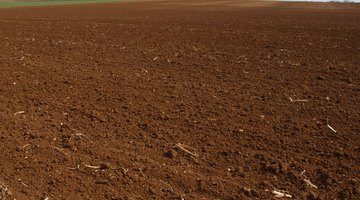What Is Loamy Sand?
Soil is made up of four basic parts: air, water, organic matter and minerals. In most soils, organic matter represents only 2 to 5 percent of the total soil volume. Water and air form about 25 percent each, and minerals make up the remaining 45 percent.

Texture is the relative proportion of the mineral components of soil: sand, silt and clay. Loamy soil contains equal amounts of the mineral components. Loamy sand contains 70 to 90 percent sand, 0 to 30 percent silt and 0 to 15 percent clay.
Sands
Sand forms the largest particles found in soil. Most sands are quartz with a few other minerals mixed in. Regular sand contains close to an even distribution of grain sizes. Each grain is large enough to be detected individually by touch and easily distinguished by viewing with the naked eye. Sands may be further subdivided into coarse, fine and very fine, according to the material's grittiness, representative percentage of grain sizes and overall feel.
Silt and Clay
Silt is soil material that contains 80 percent or more of silt and less than 12 percent clay. Silt particles are much smaller than grains of sand but are still largely composed of quartz. Clay particles, the smallest component found in soil, are plate-like in shape and contain a greater amount of nutrients than either silt or sand. Clay gives soil a sticky feel when moistened and can be made into firm casts that harden when dried.
Loamy Coarse and Loamy Sands
The United States Department of Agriculture sub-classifies the loamy sands from coarse to very fine, according to the proportion of sand separates they contain. Loamy coarse sand contains at least 25 percent of separates that are either very coarse or coarse and less than 50 percent of any other texture. Loamy sand consists of less than 50 percent of fine or very fine particles, more than 25 percent of medium particles, and less than 25 percent of the two coarsest particle types.
Loamy Fine and Very Fine Sands
Loamy fine sand contains 50 percent or more of fine sand, or less than 50 percent very fine sand in combination with less than 25 percent very coarse, coarse, and medium sand. Loamy very fine sand contains 50 percent or more of very fine sand. This soil is smooth to the touch due to the predominance of excessively fine grains. All types of loamy sands differ from sandy loams as loamy sands contain more silt separates and fewer particles of sand and clay.
The Drip Cap
- Soil is made up of four basic parts: air, water, organic matter and minerals.
- Water and air form about 25 percent each, and minerals make up the remaining 45 percent.
- Regular sand contains close to an even distribution of grain sizes.
- Sands may be further subdivided into coarse, fine and very fine, according to the material's grittiness, representative percentage of grain sizes and overall feel.
- Loamy coarse sand contains at least 25 percent of separates that are either very coarse or coarse and less than 50 percent of any other texture.
Writer Bio
Kevin Ann Reinhart, a retired teacher-librarian, has written professionally since 1976. Reinhart first published in "Writers' Undercover" Cambridge Writers Collective II. She has a bachelor's degree in English and religious studies from the University of Waterloo and a librarian specialist certificate from Queen's University and the University of Toronto.
Photo Credits
- Hemera Technologies/AbleStock.com/Getty Images
- Hemera Technologies/AbleStock.com/Getty Images
More Articles



